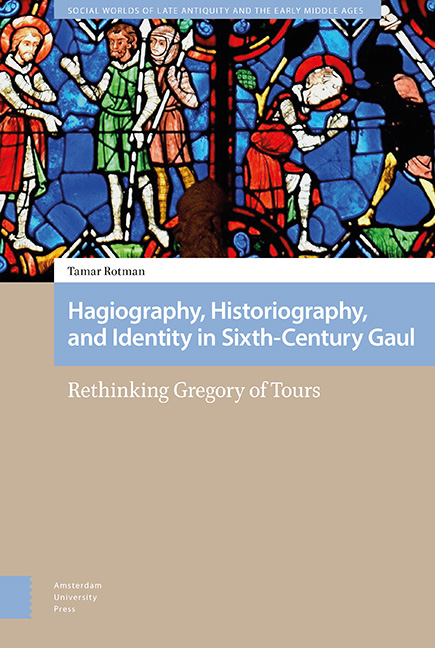Book contents
- Frontmatter
- Table of contents
- List of Abbreviations
- Acknowledgments
- Dedication
- Introduction
- 1 Gregory of Tours
- 2 ‘When the Saints Go Marching In’: Eastern Saints in Merovingian Gaul
- 3 The Miraculous History of Gregory of Tours
- 4 ‘By Romans They Refer To…’ (Romanos Enim Vocitant): History, Hagiography, and Identity
- Conclusion
- Bibliography
- Index
- Frontmatter
- Table of contents
- List of Abbreviations
- Acknowledgments
- Dedication
- Introduction
- 1 Gregory of Tours
- 2 ‘When the Saints Go Marching In’: Eastern Saints in Merovingian Gaul
- 3 The Miraculous History of Gregory of Tours
- 4 ‘By Romans They Refer To…’ (Romanos Enim Vocitant): History, Hagiography, and Identity
- Conclusion
- Bibliography
- Index
Summary
[I have written this work] to commemorate those who are dead and gone, and to bring them to the notice of future generations.
Gregory of Tours had a strong historical and historiographical acumen. Equally, he had a clear sense of his role as an author and as a historian, who records the past (‘pro commemoratione praeteritorum’) so that future generations might remember and commemorate it (‘ut notitiam adtingerint venientum’). Indeed, both his historiographical and hagiographical works were written with this notion in mind. Yet most modern historians of late antiquity and the early Middle Ages have ignored the historiographical value of Gregory's extensive collection of hagiographies. In this study, I have focused on these collections, arguing that they were meant to be read as an ecclesiastical history of the Merovingian Church.
Certain peculiarities in the text of the Glory of the Martyrs prompted me to think that this is not a simple hagiographical text, that was meant solely to commemorate saints and propagate their cults. Gregory included in this work several accounts of eastern martyrs, most of whom (as I have shown in Chapter 2) were not venerated in Gaul at that time. Some were hardly venerated anywhere. Yet Gregory chose to include them in this miracle collection without any explanation whatsoever. Luckily, Gregory left many clues along the way. In the years I spent piecing together this intricate puzzle, these clues led me to the conclusion that Gregory had, in fact, written an ecclesiastical history of the people of Merovingian Gaul in the form of three hagiographical collections.
Reading the Glory of the Martyrs, the Glory of the Confessors, and the Vita Patrum consecutively reveals a geographical and a chronological scope that binds the works together into one long historical narrative. Each collection discusses a certain period. The Glory of the Martyrs focuses on the birth of Christianity and the persecution period; the Glory of the Confessors centers on the early Christian history of Merovingian Gaul; and finally, the Vita Patrum deals with contemporary history of the Merovingian Church. This structure recalls that of Gregory's Histories, which also begins with the Creation and the birth of Christianity and ends in Gregory's own time.
- Type
- Chapter
- Information
- Hagiography, Historiography, and Identity in Sixth-Century GaulRethinking Gregory of Tours, pp. 167 - 172Publisher: Amsterdam University PressPrint publication year: 2021



